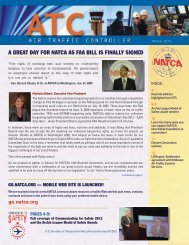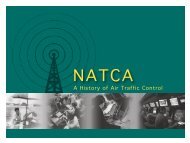Against the Wind - National Air Traffic Controllers Association
Against the Wind - National Air Traffic Controllers Association
Against the Wind - National Air Traffic Controllers Association
You also want an ePaper? Increase the reach of your titles
YUMPU automatically turns print PDFs into web optimized ePapers that Google loves.
one each to <strong>the</strong> remaining five. In a fiery speech to <strong>the</strong><br />
delegates, Kansas City Center controller Ray Spickler,<br />
from <strong>the</strong> four-state Central Region, contended <strong>the</strong><br />
divisive move would pit large facilities and regions<br />
against small ones. Delegates rejected <strong>the</strong> measure.<br />
They also considered a Sou<strong>the</strong>rn Region resolution<br />
to consolidate NATCA’s nine regions, which<br />
mirrored <strong>the</strong> FAA’s, into seven, as PATCO had done. *<br />
“We were really looking for an efficient organization.<br />
It didn’t make sense to have nine regions and it still<br />
doesn’t,” Krasner says now.<br />
Today, many agree that NATCA and <strong>the</strong> FAA<br />
would be better off with just three or four matching<br />
regions—or even a single national entity—to reduce<br />
overhead costs and foster more unity. “We’ve perfected<br />
<strong>the</strong> FAA model to an art form and we really need<br />
to stop doing that,” says Carol Branaman, who was<br />
elected Northwest Mountain Region vice president in<br />
2000. “If I had my way, we wouldn’t have a bunch of<br />
regional anything. It would be different.”<br />
But in 1988 in Atlanta, some delegates viewed<br />
<strong>the</strong> move as a power play among <strong>the</strong> larger regions.<br />
Representatives from Alaskan, Central, and New England—<strong>the</strong>y<br />
were loosely known as <strong>the</strong> Small Region<br />
Coalition—sent letters opposing <strong>the</strong> proposal to all facilities.<br />
“We feel that by limiting NATCA to only a few<br />
regions, all controllers will not get <strong>the</strong> proper representation<br />
<strong>the</strong>y deserve, and that <strong>the</strong>re will exist certain<br />
internal power structures that helped destroy PATCO,”<br />
22<br />
July<br />
T. Allan McArtor takes over as FAA administrator from Donald Engen,<br />
who resigned twenty days earlier. McArtor logged 200 combat missions<br />
in Vietnam, winning <strong>the</strong> Silver Star and Distinguished Flying Cross. He also<br />
Alaskan Regional Rep Will Faville Jr. wrote.<br />
The proposed amendment was withdrawn,<br />
though not before Barte threatened to pull New England<br />
delegates out of <strong>the</strong> convention.<br />
The First <strong>National</strong> Election<br />
Heavy lobbying ensued in <strong>the</strong> hotel’s bars and<br />
regional “war rooms,” which were making <strong>the</strong>ir first<br />
appearance at a NATCA function. The Small Region<br />
Chapter 4: The House that NATCA Built<br />
Honorary Lifetime Members<br />
FYI<br />
John F. Thornton 1988 NATCA nat’l. organizer, sr. leg. affairs director<br />
John F. Leyden 1992 PATCO president 1970-80<br />
James Breen 1994 New England regional representative 1988-92<br />
Robert D. Taylor 1994 Director of labor relations<br />
Richard Swauger 1996 <strong>National</strong> technology coordinator<br />
Cathy Meachum 2000 NATCA Charitable Foundation co-founder<br />
Emeritus Members<br />
Gary Molen 1994 Northwest Mountain Region VP emeritus<br />
Ed Mullin 1994 Southwest Region VP emeritus<br />
Barry Krasner 1996 <strong>National</strong> president emeritus<br />
Michael McNally 2000 <strong>National</strong> president emeritus<br />
flew with <strong>the</strong> <strong>Air</strong> Force Thunderbirds for two years. McArtor worked<br />
for Federal Express Corporation for eight years until his appointment as<br />
administrator.<br />
95<br />
* Under <strong>the</strong> proposal, New England Region<br />
would be consolidated into Eastern. Central<br />
and a renamed Western Region would absorb<br />
Northwest Mountain states, and several<br />
o<strong>the</strong>r realignments would occur west of <strong>the</strong><br />
Mississippi River. A new Pacific Region would<br />
include Alaska, Hawaii, and U.S. territories in<br />
<strong>the</strong> South Pacific.




